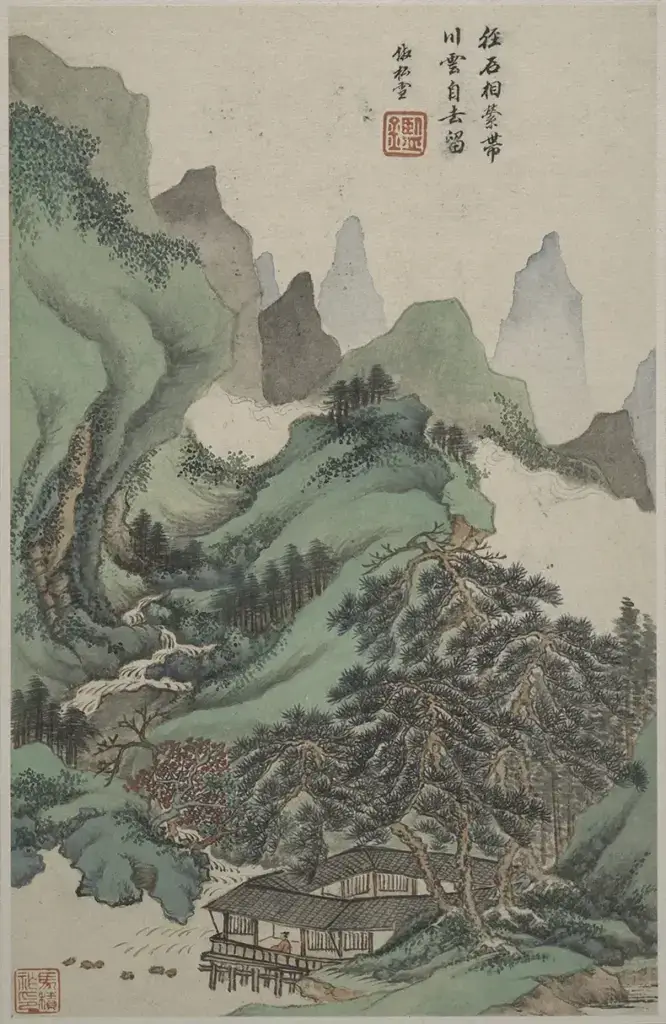Overview
In this lesson, you will make sketches of landscapes inspired by Chinese landscape paintings, photos, or personal memories.
Materials and Tools
- Drawing paper
- Ebony pencils
Objective
Students will generate and combine ideas to create landscape drawings that convey meaning or personality. They will write a poem to accompany their drawing and share more about their ideas.
Activities
Close Looking
A landscape artwork that shows a natural setting, depicting various features such as mountains, valleys, rivers, and skies. Artists all over the world have painted landscapes for thousands of years.
Let’s look closely at a landscape painting for inspiration.

- What kind of lines do you notice? How would you describe them?
- What kind of shapes do you see? What do the different shapes represent (mountains, valleys, etc.)
- Compare and contrast how the artist used different shapes and lines to paint different parts of nature.
- Look closely at the textures in the paintings. Can you see any brushstrokes or patterns? How do you think the artist created those textures?
- Imagine you’re walking into the painting. What sounds do you think you might hear? What do you see that makes you say that?
China has a long history of landscape painting. Chinese depictions of nature are seldom mere representations of the external world. They are often expressions of the ideas and feelings of the individual artists.
- How do you think the artist wants us to feel when we look at this painting?
- Do you feel the same way, or do you feel something different?
- What kind of landscape could show how you feel?
Drawing Landscapes
Take out your drawing paper and think about what features you will add to your landscape — will you add mountains, valleys, rivers, maybe a forest?
You can research images of landscape features to inspire you.
Where will you draw each feature on your paper? Some features might go in the foreground, closer to the bottom or middle of your paper. Elements in the foreground usually seem closest to us when we look at an artwork.
You can also add features in the background. What is in the background usually seems further away when we look at an artwork.
What lines, shapes, and textures will you use to draw each feature?
How will you use your pencil to create them?
Writing Landscape Poems
Artists often write about their artwork to share more about their ideas. Let’s write a poem inspired by your landscape drawing!
Look at your landscape drawing.
- What words come to mind when you look at your drawing? You might think of words that describe:
- the lines, shapes, and textures that you used — curved, bumpy, twisted, jagged, rough, or smooth;
- the features of your landscape — mountain, hill, valley, cave, river, forest, grassy, or rocky;
- the feelings that this place conveys — serene, calm, exciting, peaceful, dangerous, crowded, or spacious.
- Make a list of these words on a second paper.
- Pick one of the words or phrases that you think is most important for conveying the feeling and imagery of your landscape to title your work.
- Beneath your title, select more key words and phrases from your list that you feel are also important to your landscape drawing.
- Experiment with different arrangements of these words until you find a structure that best captures the idea of your drawing, considering rhythm and sound.
- Once you’re satisfied with your poem, revise and edit as needed to refine its language and imagery.
Vocabulary
Landscape, background, foreground
Resources
View the exhibition that inspired this lesson on the Metropolitan Museum of Art website here:
Vision and Verse: The Poetry of Chinese Painting
Credits
Written By:
Andrea Burgay, Director of Digital Learning
Lesson Development:
Julie Applebaum, Senior Director
Copyright © 2024 Studio in a School NYC LLC

